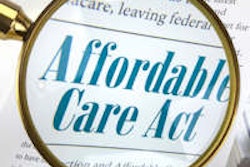
Health insurance marketplaces offer a variety of dental benefits, but figuring out which ones are best for pediatric coverage is complicated, according to a new research brief released March 27 by the ADA Health Policy Resources Center. In part one of DrBicuspid.com's coverage of the study, we looked at federally facilitated and state-based marketplaces, standalone and embedded dental plans, and services covered.
In this second part, we look at dental provider networks and deductibles, and compare coverage costs for standalone dental plans and medical plans with embedded dental benefits.
Networks
Information on dental provider networks is limited within medical plans that offer embedded pediatric dental benefits, according to study authors Cassandra Yarbrough, MPP; Marko Vujicic, PhD; and Kamyar Nasseh, PhD. They found that all standalone dental plans (SADPs) but only 56% of the medical plans provide a list of in-network dental providers that can be accessed directly through the policies' statements of benefits and coverage.
The researchers noted that 24% of the medical plans don't provide consumers with any information on in-network dental providers. Notably, they found that 48% of medical plans and 6% of SADPs do not cover out-of-network dental services.
Regarding covered services, all medical plans with embedded pediatric dental benefits and SADPs cover preventive services, according to the study authors. SADPs are slightly more likely to cover restorative and orthodontia services.
But the researchers pointed out that even after their extensive investigation, it's still unclear whether minor restorative services, major restorative services, and orthodontia services are covered in some medical plans.
Dental deductible
When medical plans use a separate dental deductible, the study found the average dental deductible is similar across medical plans ($34) and the SADPs ($41). However, 34% of medical plans do not use a separate dental deductible. In these cases, the average combined medical plus dental deductible is $2,935.
Among medical plans that do not have a separate dental deductible, the researchers said it is crucial to understand whether the deductible applies to all dental services or whether some are exempt. A high deductible with a long list of exempt services provides much higher financial protection to consumers than a high deductible with few exempt services, they noted.
They found the majority of medical plans without a separate dental deductible do not apply the deductible to preventive services. And among the 12% of plans that do apply the deductible to preventive services, the researchers noted that basic preventive dental care services are not "first-dollar covered."
Even among SADPs, only 26% of plans apply the deductible to preventive services, the study authors said. While the average deductible for SADPs is much lower, they pointed out that some SADPs do not provide first-dollar coverage for basic preventive dental care.
Comparing costs
The study compared average costs of buying pediatric dental benefits through three channels: a medical plan with embedded pediatric dental benefits, a high actuarial value SADP, and a low actuarial value SADP.
“The first thought should be to fulfill the promise that pediatric dental care is going to be covered, and you can keep your plan and you can keep your dentist.”
Association of Dental Plans
Since medical plans show only one premium, the researchers developed a way to estimate the pediatric dental benefit premium within these plans. They took the difference between the average pediatric premium for silver medical plans that have an embedded pediatric dental benefit and the average for those that do not. This "shadow" premium can be seen as the average incremental cost of buying pediatric dental coverage through a silver medical plan.
The average shadow premium across the 25 states in the study was $5.11, representing the average incremental cost of buying pediatric dental benefits through a silver medical plan. The shadow premium varies significantly across the states, ranging from -$34.10 in South Dakota to $33.83 in Alaska.
Many states actually have a negative shadow premium, the researchers noted, meaning that silver medical plans without embedded pediatric dental benefits are, on average, more expensive than silver medical plans with embedded pediatric dental benefits.
The average high actuarial value SADP pediatric premium is $38.89, ranging from an average of $27.91 in Nebraska to $77.24 in Alaska, the study found. The average low actuarial value SADP pediatric premium is $30.98, ranging from an average of $23.32 in Nebraska to $52.93 in Alaska.
The study found no relationship between the number of SADPs being offered within a state and the average pediatric premium. The researchers also found that states that offer medical plans with embedded pediatric dental benefits did not have an impact on the premiums charged by SADPs.
"These initial findings suggest that increased competition in terms of the number of plans offered may not lead to lower premiums," the researchers wrote.
SADPs versus embedded plans
Significantly more information about dental benefits is available to consumers for SADPs compared with medical plans with embedded dental benefits, the study found. But covered services and coinsurance levels are similar for both plans.
Deductibles are significantly lower within SADPs, since many medical plans with embedded dental benefits use a single deductible for medical and dental services combined. However, the researchers pointed out that most medical plans with embedded dental benefits don't apply the deductible to preventive dental care.
Also, out-of-network coverage is much more limited for medical plans with embedded dental benefits compared with SADPs, the study authors said, which is important because information on dental provider networks is more limited within such medical plans.
Among the more significant findings: The cost of pediatric dental coverage is significantly lower when purchased through embedded medical plans than in SADPs, the researchers found. But they noted that it's not easy to find enough information about the plans to make meaningful comparisons.
"With less-than-full information, it is challenging for consumers to make optimal choices," the researchers wrote.
Conclusion
Because the Patient Protection and Affordable Care Act (ACA) gives states the authority to customize how pediatric dental benefits are offered, there is significant variation. In some states, none of the medical plans has embedded dental benefits, while in other states, all of them do, the study authors noted. But all states offer SADPs.
If all medical plans were required to have embedded dental benefits, or if the states made it mandatory to buy pediatric dental benefits, then expanding dental coverage would be easy, they noted. For example, early enrollments from California, where pediatric dental benefits can only be purchased as a SADP, confirm the importance of this issue, the study authors noted. Only 27% of California children enrolling in medical plans also enrolled in a SADP through January 2014, according to a study by California Health Line.
In some cases, both medical plans and SADPs apply deductibles to preventive pediatric dental services, the study authors noted, unlike preventive medical services, which are mandated to be cost-free under the ACA.
The issue of applying deductibles to preventive pediatric dental care should be revisited, the researchers said.
"Pediatric dental care is an important component of primary care," they noted. "But the lack of first-dollar coverage for basic preventive dental services for children in some plans could impose financial barriers to care, counteracting the purpose of making pediatric dental benefits an essential health benefit."
If people choose plans based on price, they will probably buy embedded plans, the study authors concluded. But if the priority is lower deductibles and more out-of-network choices, then consumers will buy SADPs for pediatric dental benefits.
The National Association of Dental Plans (NADP) is among several organizations that are urging lawmakers to add subsidies for pediatric dental care.
NADP Director Evelyn Ireland noted that dental care is usually much more expensive than medical care on an annual basis, especially for young children.
"Dental coverage should not be always taking a back seat to medical coverage, particularly for young children," Ireland told DrBicuspid.com. "It needs to stop being the footnote or the afterthought. The first thought should be to fulfill the promise that pediatric dental care is going to be covered, and you can keep your plan and you can keep your dentist."



















